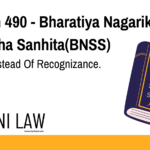Code: Section 498 BNSS
(1) When an investigation, inquiry or trial in any criminal case is concluded, the
Court or the Magistrate may make such order as it thinks fit for the disposal, by destruction,
confiscation or delivery to any person claiming to be entitled to possession thereof or
otherwise, of any property or document produced before it or in its custody, or regarding
which any offence appears to have been committed, or which has been used for the
commission of any offence.
(2) An order may be made under sub-section (1) for the delivery of any property to
any person claiming to be entitled to the possession thereof, without any condition or on
condition that he executes a bond, with or without securities, to the satisfaction of the
Court or the Magistrate, engaging to restore such property to the Court if the order made
under sub-section (1) is modified or set aside on appeal or revision.
(3) A Court of Session may, instead of itself making an order under sub-section (1),
direct the property to be delivered to the Chief Judicial Magistrate, who shall thereupon
deal with it in the manner provided in sections 503, 504 and 505.
(4) Except where the property is livestock or is subject to speedy and natural decay,
or where a bond has been executed in pursuance of sub-section (2), an order made under
sub-section (1) shall not be carried out for two months, or when an appeal is presented,
until such appeal has been disposed of.
(5) In this section, the term “property” includes, in the case of property regarding
which an offence appears to have been committed, not only such property as has been
originally in the possession or under the control of any party, but also any property into or
for which the same may have been converted or exchanged, and anything acquired by such
conversion or exchange, whether immediately or otherwise.
Explanation of Section 498 BNSS
Section 498 deals with how property involved in criminal cases is managed after a trial concludes. This includes the property presented as evidence, property related to the offence, or property used in committing the crime. The section provides for the disposal, destruction, confiscation, or delivery of such property to the rightful owner.
Key Provisions of Section 498:
- Disposal of Property: After the trial ends, the Court or Magistrate has the authority to decide whether property should be destroyed, confiscated, or returned to the person entitled to possess it.
- Return of Property: If the property is to be returned to the rightful owner, the Court may require the person to sign a bond ensuring that the property will be returned if the order is changed on appeal.
- Session Court’s Role: A Court of Session can direct that the property be handed over to the Chief Judicial Magistrate, who will manage it according to the law.
- Appeals: Orders regarding property disposal are temporarily suspended for two months, or until any appeal is decided, whichever comes first.
- Definition of Property: “Property” here includes anything connected to the crime, including any items that were converted or exchanged during the offence.
Illustrations
Example 1: Returning Stolen Jewelry
After a conviction for theft, the Court orders that the stolen jewelry be returned to the rightful owner. However, the owner may need to sign a bond, agreeing to return the jewelry if the Court’s decision is changed on appeal.
Example 2: Property Held as Evidence
During the investigation, a car is seized as evidence in a fraud case. Once the trial is over, the Court decides to return the car to the owner, but the owner must provide a bond ensuring the vehicle’s return if the Court’s order is modified on appeal.
Example 3: Disposal of Livestock
In a case involving illegal trade, a herd of livestock is seized. As livestock is subject to natural decay, the Court may decide to dispose of them immediately, without waiting for an appeal.
Common Questions and Answers on Section 498 BNSS
1. What happens to the property after the trial ends?
- Answer: The Court or Magistrate may order the property to be destroyed, confiscated, or returned to its rightful owner.
2. Can property be returned to its owner after a trial?
- Answer: Yes, property can be returned, but the owner may need to sign a bond agreeing to return the property if the Court’s decision is changed on appeal.
3. What is meant by “property” in this section?
- Answer: “Property” refers to any item involved in the offence. This includes items that were in the possession of the accused or items that have been converted or exchanged as part of the crime.
4. Is there a waiting period for the disposal of property?
- Answer: Yes, the property cannot be disposed of for two months, or until the appeal is resolved, whichever comes later. This allows time for appeals or challenges.
5. Can the Court transfer the responsibility of property disposal?
- Answer: Yes, a Court of Session can direct the property to be delivered to the Chief Judicial Magistrate, who will manage its disposal according to the law.
Conclusion
Section 498 of the BNSS ensures that property involved in criminal cases is managed responsibly after a trial concludes. It lays out clear procedures for the disposal, return, or confiscation of property, providing safeguards to ensure that the rights of owners are protected while maintaining fairness in the justice system.








